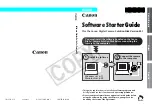
Dictionary Database Structure
Data Definition Language (DDL) Reference Manual — 426798-002
D -48
Key Definition File
For the sample dictionary shown in
Figure D-1
on page D-45, DICTRDF contains the
following values:
OBJECT: 2
DEF-NUMBER: 2
FILE-NAME: $data.sales.parts
DICTRDF.OBJECT uniquely identifies each record by its object number.
DICTRDF.DEF-NUMBER is equal to the object number of the record, unless it is
defined with a DEFINITION IS def-name clause. If the record is defined with a
DEFINITION IS def-name clause, DEF-NUMBER contains the object number of the
referenced definition.
Suppose that the following record is added to the dictionary:
RECORD newparts.
FILE IS "$data.sales.newpart".
DEFINITION IS partname.
END
DICTRDF now contains the following:
When a record is declared with a DEFINITION IS clause, DICTOBL has no entry for
the new record. Instead, the data structure is found in DICTOBL by looking up the
referenced definition number in DICTRDF.
Key Definition File
DICTKDF contains one record for each primary key and each alternate key, or each
SEQUENCE IS field declared for each record in the dictionary. DICTKDF records are
uniquely identified by the object number of the record that contains the key and an
element number.
For the sample dictionary shown in
Figure D-1
on page D-45, DICTKDF contains the
following values.
IDENTIFIER.RECORD-NUMBER: 2
OBL-KEY.OBJECT: 2
KEYTAG-VALUE: 0
Dictionary Structure Link Diagram
Figure D-2
on page D-49 is a structure diagram of the dictionary database illustrating
the main database links.
OBJECT
DEF-NUMBER FILE-NAME
2
2
$data.sales.parts
3
1
$data.sales.newpar
t
















































